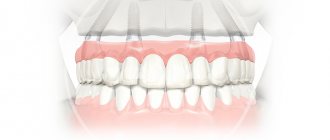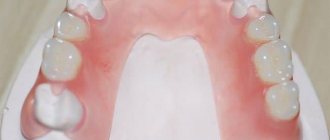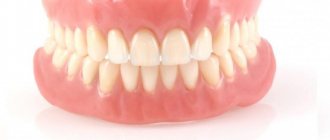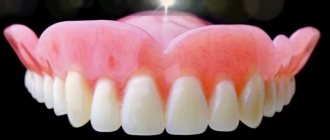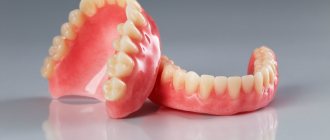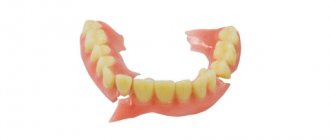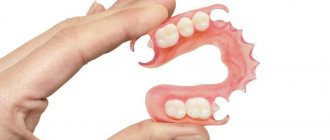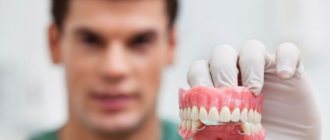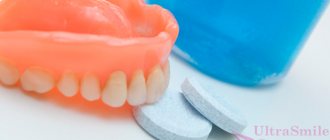News
Anatomical and physiological features of the boundaries of a complete removable denture of the upper jaw
When prosthetizing patients with complete secondary edentia, they are taken into account, which are of great practical importance.
ANATOMICAL AND PHYSIOLOGICAL PREREQUISITES FOR THE CONSTRUCTION OF THE BOUNDARIES OF COMPLETE REMOVABLE DENTURES The vestibule of the oral cavity. The vestibule has the appearance of a narrow horseshoe-shaped gap; on the outside it is limited by the mucous membrane of the lips and cheeks, and on the inside by the labial and buccal surfaces of the alveolar process of the jaw. On the mucous membrane in the vestibule area there are frenulums of the upper and lower lips and bucco-alveolar cords (folds). On the upper jaw there are four buccal-alveolar cords, which are located in the area of the transitional fold at the level of the canines and premolars. More often they are single, less often - multiple. On the lower jaw, the buccal alveolar cords are located in the canine area. As the alveolar processes of the jaws atrophy, the place of attachment of the frenulum changes. With slight atrophy of the jaw bones, the vestibule of the oral cavity has a high arch, the frenulum of the upper and lower lips are located at the base of the alveolar process. The size of the frenulum of the lower lip is, as a rule, somewhat smaller than the frenulum of the upper lip. The frenulum of the upper lip can be shortened and then a gap appears between the central incisors - a diastema. With significant atrophy, the arch of the vestibule flattens, the frenulum extends onto the alveolar process, and with deep atrophy it can be located at the level of the top of the crest of the alveolar process of the jaw. In cases of its high attachment, during contraction of the facial muscles, the frenulum can be stretched and displaced, which leads to the prosthesis being thrown off. To prevent shedding, a recess should be created in the prosthesis. The size of the recess for the lip frenulum should be minimal, that is, strictly correspond to the height and width of the frenulum, in order to avoid injury to it and maintain the continuity of the circular closing valve in this area.
It follows that the most favorable for prosthetics is a high arch of the vestibule of the oral cavity and low attachment of the frenulum. ANATOMIC AND PHYSIOLOGICAL RATIONALE FOR THE BORDERS OF A COMPLETE REMOVABLE DENTURE FOR THE UPPER JAW The shape of the vestibular slope of the alveolar process of the upper jaw.
Depending on the degree of atrophy, three types of vestibular slope of the alveolar process are distinguished:
1) sloping;
2) sheer;
3) with a “canopy”. The most favorable for creating and maintaining a closing valve on the prosthesis during chewing are alveolar processes with a steep vestibular slope, because with small displacements, the edge of the prosthesis slides along the mucous membrane of the alveolar process and fits tightly to it, forming a closing valve, i.e. contacts of the edges of the prosthesis with the slope of the jaw are not disturbed. Less favorable for prosthetics are sloping slopes, in which the prosthesis is freely applied to the jaw, but with small displacements, contact with the mucous membrane is lost. With this shape of the alveolar process, prostheses with expanded boundaries are indicated to achieve and maintain the valve effect. Unfavorable are processes with a “canopy”, in which the base of the prosthesis can injure the mucous membrane due to the presence of bone protrusions on the alveolar processes that appeared after tooth extraction. In addition, in the presence of such processes, it is difficult to create conditions conducive to good suction of the prostheses. Shape of the vault of the hard palate. Depending on the degree of atrophy of the upper jaw, a high, flattened and flat arch of the hard palate is distinguished. A high vault of the palate is most favorable for prosthetics, because it is a point of anatomical retention and limits the movement of the prosthesis in the transversal direction.
Relief of the palatal suture.
The suture of the hard palate is formed by the connection of two bone plates.
He can be:
1) convex due to the bony prominence - the torus, the size and shape of which vary. This form of the palatal suture complicates prosthetics, because when making a prosthesis, the torus must be isolated;
2) smooth - with atrophy of the maxillary bone of class 3 according to the Kurlyandsky classification;
3) concave - most convenient for prosthetics. Incisive papilla. Along the midline of the upper jaw, slightly distal to the apex of the alveolar process, is the incisive papilla. With atrophy of the alveolar process, it may be located directly at the top of the alveolar ridge. The incisive papilla is a prominence of soft tissue covering the incisive foramen from which blood vessels and nerves emerge. When an impression is taken, it is usually compressed. Subsequently, to prevent irritation of the papilla, which can be caused by the pressure of the prosthesis, it is necessary to ensure unloading of the underlying tissues in this area and avoid their displacement during impression taking. In the absence of teeth, the incisive papilla serves as a guide to determine the midline of the model. Transverse palatal folds. In the anterior third of the hard palate, the incisive papilla is bordered by transverse palatal folds - from 3 to 6 on each side. These anatomical structures must be clearly depicted on the cast. Otherwise, they will be pinched and cause pain when using the prosthesis. The maxillary alveolar cusps are located in the distal parts of the alveolar process. They are points of anatomical retention. In case of terminal defects of the dentition and in the complete absence of teeth, the maxillary cusps are always covered by the base of the prosthesis, but in no case should it go further, because Behind the tubercles there are pterygomaxillary folds, which straighten when the mouth is opened strongly, and therefore can throw off removable dentures.
The blind (palatal) fossae are located on the sides of the posterior nasal spine. They represent the fusion of the excretory ducts of the mucous glands, the openings of which are located in close proximity to line “A”. The blind fossae are a convenient reference point for determining the posterior edge of the prosthesis. Structure of tissues of the mucoglandular zone. E.I. Gavrilov introduced the concept of “buffer zones” back in 1962. He noted that the mucous membrane of the hard palate is pliable not only due to the presence of fibrous structures, but also mucous glands and a dense network of blood vessels. The mucous membrane covering the alveolar process and the palatal suture area has minimal buffering properties. As you approach the base of the alveolar process and the soft palate, the buffering properties increase. The tissues of the posterior third of the hard palate have the greatest buffering properties. Line “A” is the boundary between the hard and soft palate. It can be presented as a zone of varying widths. The vibrating zone “A” is the area of the mucous membrane that is detected when pronouncing the sound “A”. The direction of the vibrating zone usually varies according to the shape of the palate: the higher the palatine vault, the more anterior this line is located and the sharper its bend. With a flat palate, the vibrating zone “A” usually extends posteriorly and is characterized by a smooth bend, thus forming its wide posterior edge. Line “A” (vibrating zone “A”) serves as a guide to determine the boundary of the posterior edge of the removable denture: in the absence of teeth, it should overlap it by 1-2 mm. Forms of the soft palate. The degree of possible lengthening of the distal edge of the prosthesis also depends on the shape and magnitude of the inclination of the soft palate in relation to the pharynx. There are three forms of the slope of the soft palate: steep, gentle and average. With a steep, steep palatine slope, the posterior edge of the hard palate corresponds to the place of transition of the fixed mucous membrane into the moving tissues of the soft palate. In such cases, the palatal valve appears as a narrow strip, and the possibility of lengthening the distal edge of the prosthesis is very limited (the prosthesis is then reset, and the patient has a gag reflex). With a gentle slope of the soft palate, the width of the palatine valve can be maximum, which allows the distal border of the prosthesis to be lengthened to improve its fixation. With an average inclination of the soft palate, the width of the palatine valve is of average size.
Borders of the product on the lower jaw
The base plate, made for a movable jaw, has individual characteristics, namely:
- The edge lines of the product in the area of edentulous areas go higher in the area of the deepest part of the arch by a maximum of 1 mm. The base is equipped with special recesses in the area of the lateral bands and bridle.
- With correct occlusion, the degree of overlap of the frontal and lateral healthy teeth is equal to 2/3 of the height of their crowns in the places of their contact with the base.
This makes it possible to increase the area of the plate, improve its stabilization by firmly enveloping each unit and prevent settling into the underlying structures. - The lower edge lines of the plate are located just above the transitional fold, while the area of the hyoid frenulum does not overlap.
If a patient is diagnosed with long terminal defects of the dentofacial arches, then the location of the distal border will be in the area of mucous protrusions with their partial overlap. Complete overlap is also possible in case of pronounced mobility in certain areas. - The width of the plate must be sufficient, because
in the process of chewing food and when talking, the entire structure begins to move upon contact with moving tissues. Fixation of the prosthesis is carried out in the spaces between the buccal, pterygoid and muscles of the same name to areas immobile for jaw movement. This placement technique increases the fixation of the entire structure, especially if the lower jaw is completely edentulous.
There are cases when it is quite difficult to install a prosthesis: osteochondral growths in the area of small molars.
After explaining the features of the clinical picture to the patient and obtaining his consent, benign neoplasms are removed and only after that a dental product that replaces teeth is fixed.
Method of manufacturing a combined model
Models of bases are produced where plastic masses are used in combination with metal alloys.
There are technical features of manufacturing a combined model of the prosthesis base, while the base can be made by casting or stamping the material:
- Using the casting method, technologists make bases for the upper or lower jaw from an alloy of chromium and cobalt. Such bases cover the mucous membrane on both sides: a plastic part on the vestibular side, a metal part in the palate area.
- The boundaries of the metal base of the toothless upper jaw are of three types. The first two types are used to treat patients with allergic reactions to metal.
The metal base of the first type completely covers the prosthetic bed, thus preventing the material from coming into contact with natural tissues.The base of the second type is located within the hard palate and the slope of the alveolar process, and the base of the third type has reduced boundaries, covering only part of the hard palate. Bases of the third type are indicated for patients with atrophy of the alveolar process or sensitive mucous tissue.
- The boundaries of the base of the edentulous lower jaw are of two types: those corresponding to the volume of the prosthetic bed, and the base with shortened boundaries.
The first type of design is used for intolerance to acrylic. The second type is used for patients who have frequent breakdowns when using plastic prostheses. - The base model is made of high-strength gypsum, then the model is duplicated and made of refractory mass.
Modeling is carried out using clasp wax, excess material is removed over an open fire, and then the retention loops are positioned. After this, the technologists create a smooth flow of material from the plastic mass to the metal alloy. Then the resulting model is molded, and at the same time a metal base is made. After processing the cobalt-chromium alloy, the base is connected to a pre-fabricated model.
This is interesting: Composite veneers and componeers: what are they, before and after photos
Metal prostheses, despite a large number of positive characteristics, have a significant drawback. They are heavier than plastic bases, so they are not often used for the upper arch.
